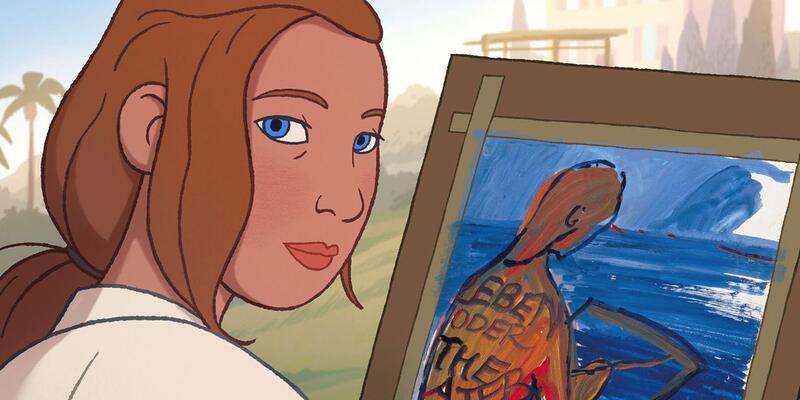A New Film About Charlotte Salomon Strips Her Soul from Her Art
Éric Warin and Tahir Rana’s film Charlotte, about the life and work of German- Jewish painter Charlotte Salomon, premiered at last year’s Toronto International Film Festival before receiving a wide release this spring. The animated film stars Keira Knightley as Salomon and follows her from her adolescence in Berlin to her years hiding from the Nazis in southern France.
Despite a star-studded cast and animated recreations of Salomon’s work that burst to life onscreen, Charlotte falters in its examination of Salomon’s history—and what the film chooses to omit says more than what it includes.
Charlotte is a film that with so much potential: It’s a coming-of-age narrative of an artist murdered in her prime, one whose life’s work was almost lost to history and who still remains largely unknown outside Europe and the Jewish community. Salomon not only depicted her life story in her work, but supplemented her paintings with text. In doing so, she created a singspiel, a German form of narrative opera, that used Christoph Willibald Gluck’s opera Orfeo ed Euridice to frame a narrative about her grandmother, her mother, and herself. The work, called Leben? oder Theater? (Life? or Theater?) is not simply a diary or a study in painting, but a masterwork created in the storied German artistic tradition of the gesamstkunstwerk, a total work that combines genres and mediums to create a sense of enlightenment.
Warin and Rana’s film, however, doesn’t introduce this concept or frame Salomon’s work as part of a broader tradition. The film instead posits Salomon’s work as the “first graphic novel,” a term with its own literary and artistic history outside of the gesamstkunstwerk. Yet Salomon surely was aware of the practice as she created Leben? oder Theater? in hiding in France; she was not so naïve as to think that she was creating an entirely new artform, but was instead emulating the artists that had come before her.
Charlotte frames its title character as more of a wunderkind and less of a scholar. When another character asks her if she is aware of other works like Leben? oder Theater?, Charlotte replies, “I don’t know. Probably not.” The implication that Salomon would not have been familiar with the songspiel or its cultural context infantilizes her work and legacy, undercutting the thesis of the film. What could have been an innovative look at a forgotten artist instead becomes another cookie-cutter biopic.
Charlotte also sidesteps discussions of mental illness and abuse, abandoning nuance for the revelation of a family history of suicide that sparks depression in the character seemingly overnight. While Leben? oder Theater? is a dense and dark work that explores suicide as an expression of agency in modern womanhood, Charlotte does not dig deeper into the role that suicide played in Salomon’s family. Salomon’s mother died by suicide. The family instead told young Charlotte that she had died in a flu outbreak, and this is accurately depicted in the film. Salomon discovered later, however, that not only did her mother die by suicide, but so did her great-grandmother, her mother’s sister after whom she was named, and many other members of her extended family. Her grandmother, sick and bedridden, ultimately died in the same manner as Salomon’s mother: by throwing herself out a window. Multiple haunting paintings from Leben? oder Theater? show women’s bodies seeming to come out of each other in a linear progression, including one that leads Charlotte’s mother out of a window and into the arms of God.
In Leben? oder Theater?, Salomon writes at length about what she believed was the inevitability of her impending death—not necessarily by murder, though her writing was infused with an awareness and anxiety that she might be killed and that she needed to finish her magnum opus before the Gestapo found her or her family’s illness took hold of her. Charlotte paints this anxiety as one solely associated with the Holocaust. While Salomon was of course worried about being discovered and deported, she was as preoccupied with suicide as she was with the Nazis. She feared not only that she might be murdered at the hands of the state, but that she may not be able to escape her family’s history of suicide.
In the film, Salomon’s grandfather (Jim Broadbent) is the one to tell her of her family’s struggle with suicide after her grandmother’s death. He is portrayed as a curmudgeon, a gruff figure who scowls every time a man tries to get close to his granddaughter and whose anger only grows as his life becomes restricted by both illness and the reach of Nazism. When Salomon poisons her grandfather in the film, it is almost a mercy killing, done in part to escape his anger but also to ease his suffering. In letters addressed to a former lover that scholars uncovered in 2015, Salomon confessed to poisoning her grandfather and then sketching his body in retaliation for sexual abuse.
Contemporary scholars have struggled to determine whether this letter was a dramatized version of events Salomon rejected from Leben? oder Theater? or whether it was a real reflection on her relationship with her grandfather; she purposefully blurs the line between truth and fiction in her work, writing with the self-aware artifice of great diarists and letter writers. Charlotte producer Julia Rosenberg said at a screening that she was aware of the confessional letter, although the sexual abuse subplot was left out of the film. This decision was surely not made to make Charlotte a more family-friendly film that could be used as an educational tool about the Holocaust; there are multiple closeups of Salomon in bed with the men of her story. Perhaps the abuse was left out of the film because it could not be proven, but that was the very nature of a work like Leben? oder Theater?—it made the reader question what was real and what was theater.
Though the two works are different in form and content, Leben? oder Theater? has often been compared to Anne Frank’s diary. Both were written by young people in hiding during the war, and both play with fact and fiction for heightened dramatic effect. (Frank edited and reordered portions of her diary and short stories to make her story as literary as possible.) Frank’s diary was manufactured into a tale of hope and perseverance after the war, with unsavory portions, like Frank’s mocking of German soldiers or references to her own puberty, left out, until publishers restored a fuller version in the 1990s.
Salomon’s story was less marketable than Frank’s, too blunt in its exploration of inherited trauma and the meaning of pain. Charlotte tries to make her story more palatable, stripping it of its theatricality and poetry and focusing instead on the potential goodness of humanity. It even ends with a Desmond Tutu quote about hope rather than with Salomon’s own words. Rosenberg told the screening audience that she hoped people would be inspired to Google Charlotte Salomon. It appears that the team behind Charlotte stopped their research on page one.








I have only read this review and have not been able to see the animated move. There seems to be no mention of her Her relationship with Alfred Wolfsohn whom she calls "Daberlohn" in her singspiel. He appears to have been her first lover. His philosophy of Life and Art impacted her deeply. I met her step mother, Paula Lindberg, years ago years ago when I was working on a production of Charlotte's work. Wolfsohn existed and it is clear in Charlotte's paintings and writings that he had an enormous impact on her life as an artist. I do wonder why this was left out of this new work.